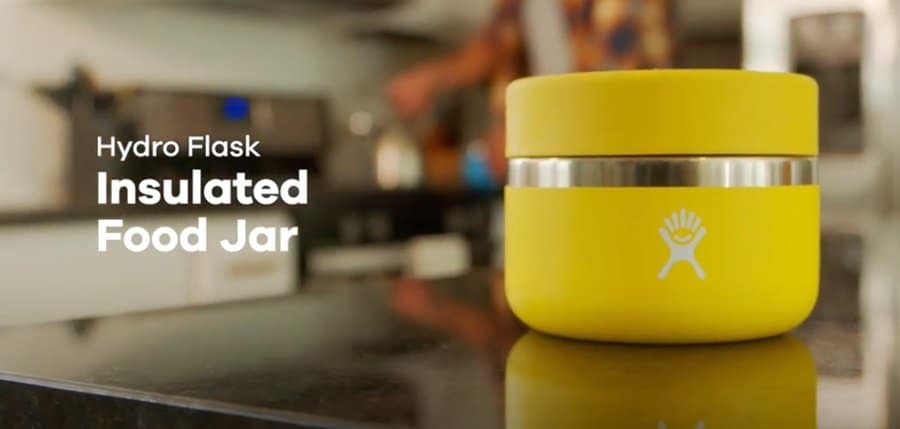We independently evaluate all recommended products and services. If you click on links we provide, we may receive compensation. Learn more.

Large, Removable Gaskets Were Easiest to Clean
Most of the thermoses were relatively easy to clean by hand. Even the ones with the narrowest openings could still fit a sponge inside, and there were no signs of staining on the metal interiors during our testing. Over time, though, the soft gaskets in the lids could become prone to staining or pick up odors or gunk. All of the insulated jars we tested had removable seals that could be washed separately, but we particularly liked the Hydro Flask’s red silicone one, which was broad enough that it could be put into the dishwasher apart from the lid without us fearing it would get lost or destroyed (a missing or misshapen gasket can lead to leaking and reduced insulation power). If the thermos had an exposed pressure release gasket, we also evaluated those. Most were easy to remove and replace except for Bentgo’s, which we struggled with for several minutes before we got it back in.
Cold Retention Wasn’t Great
None of the thermoses kept the egg salad below 40°F for more than two hours, but it wasn’t necessarily because of a flaw in their insulation (although size and shape did play a part, just like in the heat retention test). To understand this, let’s consider the temperature ranges of food safety. When we heat soup, for example, we usually warm it to at least a simmer (around 200°F). It can cool by 60°F before it becomes a bacterial haven. Refrigerated food, on the other hand, must be held below 40°F but above 32°F lest it get icy. Even if food is nearly frozen, it only has about an 8°F window before it enters danger zone territory.
Realistically, though, most fridge-cold food is closer to 40°F than it is to 32°F, especially for items stored toward the front of the refrigerator. When we first started the cold retention test, we found that our egg salad—which had been chilled overnight—was a consistent 38°F throughout. We stashed the salad in the freezer for about 10 minutes to chill it down to 34°F before starting, although extra steps like that may not be convenient when packing lunches on busy mornings. Many manufacturers also suggested that their thermoses be pre-filled with cold water and allowed to sit for 10 minutes to help cold retention (the same thing goes for hot water and heat retention), or stored in the refrigerator overnight. Users could also add a few ice cubes to the jar, or put their food in after it has been frozen (since none of the thermoses we tested were freezer-safe themselves).
Ultimately, it is also important to consider that food doesn’t become immediately unsafe when it enters the danger zone. The USDA allows for one to two hours for food to sit at room temperature before it needs to be re-chilled or discarded. While using thermoses for cold food is a little trickier than for hot, they can still be used to buy some extra time.
Hydro Flask Food Jar Hot And Cold Test
Can you put soup in a Hydro Flask?
Yes, you can put soup in a Hydro Flask. And it doesn’t matter if it is a chunky soup or a smooth soup. If you’re putting a hot soup in the Hydro Flask, then it should stay warm for at least six hours. (though you should likely eat it sooner for food safety) Likewise, a cold soup (like gazpacho) will stay cold in a Hydro Flask.
Can you put boiling water in a Hydro Flask?
Yes, you can put boiling water in your Hydro Flask. In fact, these flasks can keep your water hot for at least 6 to 12 hours. So whether you need water for noodles or coffee, these flasks are a good way to store your water. Can you put hot chocolate or tea in a Hydro Flask? Yes, you can put hot tea and chocolate in your Hydro Flask.
Can you put hot tea in a Hydro Flask?
Yes, you can put hot tea and chocolate in your Hydro Flask. These flasks can even keep your hot beverages hot for 12 hours. What should you not put in a Hydro Flask? If there is one thing that should never get anywhere near your Hydro Flask, it is bleach/chlorine.
Can you put hot coffee in a Hydro Flask?
Since hot coffee isn’t that acidic, it can be put in a Hydro Flask without damaging it in any way. In fact, it’s not even as acidic as soda. Beyond that, it’s worth noting that most coffee machines are made of stainless steel – the same material that makes up the inner lining of Hydro Flasks.
